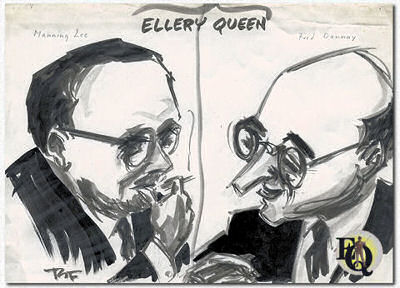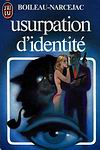
 |
|
TO PAGE: 1 • 2 • 3 • 4 • 5 • 6 • 7 • 8 • 9 • 10 • 11 • 12 • 13 • 14 • 15 |
![]()
PASTICHES (1)
 n 1944
Ellery Queen
edited
The Mis-adventures of
Sherlock Holmes an
an-thology of Holmesian pastiches and n 1944
Ellery Queen
edited
The Mis-adventures of
Sherlock Holmes an
an-thology of Holmesian pastiches and parodies. He used this form of flattery to pay tribute  Above: Thor Fredric (Tor Fredriksson, 1913 - 1961) did cartoons for the Swedish language press in Finland during the 1930s and through WWII. Some samples of it were rediscovered in a book about WWII cartoons in 2014. Picture Courtesy Jyrki Vainio Ellery Queen once described the difference between pastiche and parody in various ways: "A pastiche is a serious and sincere imitation in the exact manner of the original author. But writers of parodies, which are humorous or satirical take-offs, have no such reverent scruples. They usually strive for the weirdest possible distortions, and many ingenious travesties have been conceived." "A parody is a burlesque imitating some serious work; a pastiche is usually a serious imitation in the exact manner of the original author. Only the illustrious call forth such passionate homage. ... The pastiche, whose intent is serious, and the fashioning of which requires immense knowledge, discrimination, and courage, is necessarily a rare literary form." (101 years of entertainment - 1946) In listing these stories (pastiches, spoofs, tributes,...) we do have to bear in mind that our subject is not only a detective (1) but also writer (2) and editor of a magazine (3). Let's start with the detective...
|
 In
1945 Thomas Narcejac wrote "Le
mystère des ballons rouges : à la manière d'Ellery Queen"
it was first published in Nouvelles confidences dans ma nuit
(1947). Later it found it's way
into a collection of pastiches of the great detectives called Usurpation
d'identité published in France in 1959 (1983, 2001).
In total it contained some 18 stories. Since March 2018 it's available in
English as "The Mystery of the Red Balloons" in the anthology
The Misadventures of
Ellery Queen. In
1945 Thomas Narcejac wrote "Le
mystère des ballons rouges : à la manière d'Ellery Queen"
it was first published in Nouvelles confidences dans ma nuit
(1947). Later it found it's way
into a collection of pastiches of the great detectives called Usurpation
d'identité published in France in 1959 (1983, 2001).
In total it contained some 18 stories. Since March 2018 it's available in
English as "The Mystery of the Red Balloons" in the anthology
The Misadventures of
Ellery Queen. |
|
|
| Hardly a pastiche but surely a form of recognition albeit outside the field of mystery. In the Jerome Chodorov and Joseph Field' 1954 - 1955 play Anniversary Waltz, the leading character is subjected to a barrage of questions and responds by asking "Who are you, Ellery Queen?" |
| From the popular I Love Lucy series season 4 episode 4 "The Matchmaker" (Episode aired Oct 25. 1954): When an angry Ricky doesn’t come home from work one night, Fred placates a worried Lucy by saying “Suppose we wait a couple of weeks and notify Ellery Queen.” |
|
While we are on the subject of 'non-printed' tributes
we can also add the doo-wop group
"The Olympics" who, in 1959 had a
hit called "Private Eye" which
had the lines: "I wanna be a private eye I'm gonna get real mean like Ellery Queen" Clearly written by someone who didn't read a lot of Queen novels... |

|
"Ten Month's Blunder" (1961) by J. N. Williamson features detective Celery Keen in a dying message story. What does the word FAN written in blood indicate? The set-up is a classic, three suspect, elimination-style story. As parody, reasonably entertaining, but as often is the case, the interpretation of a dying message can be troublesome, since it requires somewhat specialist knowledge. (Ho-Ling Wong) If Ellery Queen had ever been a supporting player in pastiches from the 60s onwards this wasn't the case. In the amusing "The English Village Mystery" by Arthur Porges (EQMM, Dec 1964) we find Mr.Celery Green solving a crime at Tottering-on-the-Brink, England. He is still in England when in the nearby community of Fretful Porcupine he made his next and last appearance In this "The Indian Diamond Mystery" (EQMM, Jun 1965) he is described as "brash, airy, sometimes flippant, and given to hasty conclusions". These airs the first but not the last of pastiches who used Queen's early method of naming mysteries.  Eve Titus is the author of twenty children's books, including those about the Basil of Baker Street. One of those stories made it into an enjoyable Disney movie. Both in Basil & The Lost Colony (1964) and Basil & The Pygmy Cats (1971) there are several cameos by Tillary Quinn. Norma Schier wrote several stories in imitation of famous detective writers, she used anagrams for names of the sleuths and authors. She let Leyne Requel star in "Dying Message" (EQMM, Jul 1966) a fine example of titular gambit where almost everybody and anything to do with EQ was reduced to anagrams. At the time of publication in EQMM Dannay added an editor's note explaining all the anagrams Schier hid in the story. These stories were collected in The Anagram Detectives (Otto Prenzler Mysterious Press, 1979). |
||
| "Elroy Quinn' Last Case" (EQMM, Jul 1967) is a poignant pastiche written by Dennis M.Dubin and involves an old and very infirm EQ who's called upon by Inspector Velie, Jr to solve a crime which threatens any chance for world peace. If the clues are guessable, they are also fun for reader of the Queen canon. | An intermezzo of a different kind. Queen actually did return in a spoof, in a comic called New Inferior 5 (Nr.7 Mar-Apr 1968) the five 'heroes' encounter "Allergy Queen" the sleuth for a criminal mastermind. Right before his great revelation Allergy is reduced to dust... | |
| In "The Cataloging on the Wall" by David Peel (Wilson Library Bulletin, Apr 1971) contained a "Challenge to the Reader" and had librarian/ drug addict/ writer/ editor/ detective Quellery Een find a replacement for his deceased cataloger Slinki Porter (whom he himself killed). | ||
|
Jon
L. Breen Breen did this once over in "C.I.A. Cune's Investigatory Archives. PLAGARISM DEPARTEMENT: The Idea Man" (The Queen Canon Bibliophile Volume 1 Nr.4 1969) and twice in EQMM "The Swedish Boot Mystery" (EQMM Nov 1973) and "The Adventure of the Disorientated Detective" (EQMM Sep 1976) all with variations on the "dying message". |
||
|
"Open Letter to
Survivors" by Francis
M.Nevins
"Whodunit?" (1976) (Jean Paul Satire aka Peter David & Myra "Emjay" Kasman) is a parody and crossover between Star Trek (the original series) and Hutton's Ellery Queen. In the TV show of Ellery Queen, starring Jim Hutton. James T. Kirk is found murdered (burnt to death by a phaser and margarine!) in his quarters, leaving only the dying message Uhu and Ellery, inspector Queen and Velie have to find the murderer among the crew of the USS Enterprise! The setting is bizarre, but it is definitely written as an "episode" of the Ellery Queen TV show, complete with the story beginning with several dialogue cuts featuring all the suspects and a Challenge to the "Viewer" (?)! Near the end, the story becomes more relient on Star Trek-fandomania Entertaining but weird. (Ho-Ling Wong) |
||
 Marty Pasko wrote the script for a 12 page Batman-comic
story
called "A Clue Before Dying" (Detective
Comics N°. 459 - May 1976). Batman tries to find the man who killed
mystery writer Elliot Quinn, and who may be the same man who killed an
architect in Quinn's home years ago. Not only an homage to Queen but in
the story also "a" Lt. Dannay appeared! Marty Pasko wrote the script for a 12 page Batman-comic
story
called "A Clue Before Dying" (Detective
Comics N°. 459 - May 1976). Batman tries to find the man who killed
mystery writer Elliot Quinn, and who may be the same man who killed an
architect in Quinn's home years ago. Not only an homage to Queen but in
the story also "a" Lt. Dannay appeared! |
||
|
Again we take a sidestep into the realm of
pop music. A little
more known than our previous examples is the 1977 Tavares hit single "Whodunit"
written by K.St.Louis and F.Perren: "... She went dancin' in the dark, somebody stole her heart Ellery Queen if you're so keen Won't you help me find my sweet thing (Yeah, yeah)..." |
||
|
|
||

|
| Introduction | Floor Plan | Q.B.I. |
List of Suspects | Whodunit? | Q.E.D. | Kill as directed | New | Copyright Copyright © MCMXCIX-MMXXV Ellery Queen, a website on deduction. All rights reserved. |